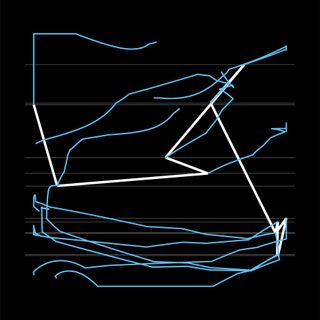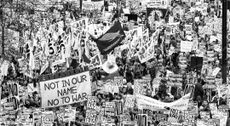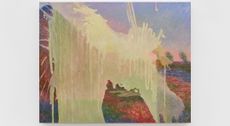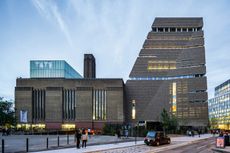Algorithmic art: Manfred Mohr talks remix, revolution and fixing radios

‘The idea to create art from algorithms is the center point of my work – that a non-visual logic will create a visual entity is what is so exciting about this process,’ explains New York-based artist, Manfred Mohr, whose work is on display in 'Artificiata II', from next week at Carroll / Fletcher in London.
Known as ‘the godfather of digital art’, Mohr began his career as a painter, going digital in the late 1960s. This shift stemmed from his childhood hobby of back-yard engineering (‘building radios and amplifiers’) alongside a pre-existing fascination with notation. Mohr found his art ‘slowly transforming from abstract expressionism to computer generated geometry’.
When Mohr was first exploring algorithms, his contemporaries were shunning the computer as pro-capitalist paraphernalia. The international student protests of 1968 ‘produced an aggressive hate for computers, which the students called bourgeois and military machines’. Mohr was physically and verbally attacked in Paris because of his preference for the medium, and one of his works (displayed in the historic Salon de Mai) was destroyed by activists.
Despite the social stigma, and the distinct lack of available computers to learn on, Mohr found a way to experiment with every dimension of digital art – even if this meant ‘fearlessly and courageously walking into the Meteorology Institute in Paris to ask for access to their machines’. He was also propelled by digital-music pioneer Pierre Barbaud, whom he first met in 1967. The freeform, jazzy notes remain in Mohr’s work to this day.
Once Mohr had gone digital, he never went back. ‘I experimented, in 1971, with a light pen to digitise a circuit board and in 1974 I modified a plotter to make etchings by tracing with a sharp steel needle on treated copper plates.
'In 1972–75, I made experimental computer movies using a microfilm camera, which had been developed just a few years before. I built, in 1967, electronic sound installations and in 1990, I used a computer-based laser to cut large reliefs out of metal plates,’
In 2002, unfulfilled by the limitations of existing programming, Mohr built his own PCs to run animations of his work, in one of his most resourceful acts of innovation. Sometimes out of necessity, and whether working with technology or not, ‘the artist always has to find or invent his own tools’.

Mohr began his career as an abstract, impressionist painter; he turned to computerised media in the late 1960s. Pictured: P1682_1866, Pigment ink on paper, 2014–15

Since then, he has utilised computerised algorithms to create geometric shapes and forms in his work. Pictured: P2202_3260, Pigment ink on paper, 2014–15

Mohr was inspired and encouraged by French digital-music pioneer Pierre Barbaud; freeform, jazzy undertones mark his practice to this day. Pictured: P2200_3099, Pigment ink on paper, 2014–15

Manfred Mohr in 2015. Courtesy Carroll / Fletcher
INFORMATION
'Artificiata II' is on view from 12 February – 2 April 2016. For more information, visit Carroll / Fletcher's website
Courtesy the artist and Carroll / Fletcher
ADDRESS
Carroll / Fletcher
56 - 57 Eastcastle Street
London, W1W 8EQ
Wallpaper* Newsletter
Receive our daily digest of inspiration, escapism and design stories from around the world direct to your inbox.
-
 Santa Monica hotspot The Georgian Room is a rare, well-done steakhouse speakeasy
Santa Monica hotspot The Georgian Room is a rare, well-done steakhouse speakeasyHidden inside The Georgian Hotel in Santa Monica, a restored speakeasy that lovingly nods to its storied past
By Kevin EG Perry Published
-
 In St Barths, Cheval Blanc is an oceanside oasis soaking in turquoise views
In St Barths, Cheval Blanc is an oceanside oasis soaking in turquoise viewsFollowing its 10th anniversary, Cheval Blanc St-Barth continues to shine as a pearl of the Caribbean
By Tianna Williams Published
-
 We celebrate the emerging London architects to be excited about
We celebrate the emerging London architects to be excited aboutThese emerging London architects are some of the capital's finest ground-breakers, movers and shakers; heralding a new generation of architecture
By Ellie Stathaki Published
-
 Steve McQueen presents a portrait of protest in Britain
Steve McQueen presents a portrait of protest in BritainTurner Contemporary’s groundbreaking exhibition Resistance reframes the history of protest, reminding us of photography’s political potential
By Millen Brown-Ewens Published
-
 When galleries become protest sites – a new exhibition explores the art of disruption
When galleries become protest sites – a new exhibition explores the art of disruptionIn a new exhibition at London's Auto Italia, Alex Margo Arden explores the recent spate of art attacks and the 'tricky' discourse they provoke
By Phin Jennings Published
-
 'It's a metaphor for life': rising star and 'Queer' poster artist Jake Grewal on his new London exhibition
'It's a metaphor for life': rising star and 'Queer' poster artist Jake Grewal on his new London exhibitionBritish artist Jake Grewal speaks to Simon Chilvers about 'Under the Same Sky' as it opens at Studio Voltaire in London
By Simon Chilvers Published
-
 Wallpaper* Design Awards 2025: Tate Modern’s cultural shapeshifting takes the art prize
Wallpaper* Design Awards 2025: Tate Modern’s cultural shapeshifting takes the art prizeWe sing the praises of Tate Modern for celebrating the artists that are drawn to other worlds – watch our video, where Wallpaper’s Hannah Silver gives the backstory
By Hannah Silver Published
-
 Inside the distorted world of artist George Rouy
Inside the distorted world of artist George RouyFrequently drawing comparisons with Francis Bacon, painter George Rouy is gaining peer points for his use of classic techniques to distort the human form
By Hannah Silver Published
-
 ‘I'm endlessly fascinated by the nude’: Somaya Critchlow’s intimate and confident drawings are on show in London
‘I'm endlessly fascinated by the nude’: Somaya Critchlow’s intimate and confident drawings are on show in London‘Triple Threat’ at Maximillian William gallery in London is British artist Somaya Critchlow’s first show dedicated solely to drawing
By Zoe Whitfield Published
-
 Surrealism as feminist resistance: artists against fascism in Leeds
Surrealism as feminist resistance: artists against fascism in Leeds‘The Traumatic Surreal’ at the Henry Moore Institute, unpacks the generational trauma left by Nazism for postwar women
By Katie Tobin Published
-
 Looking forward to Tate Modern’s 25th anniversary party
Looking forward to Tate Modern’s 25th anniversary partyFrom 9-12 May 2025, Tate Modern, one of London’s most adored art museums, will celebrate its 25th anniversary with a lively weekend of festivities
By Smilian Cibic Published